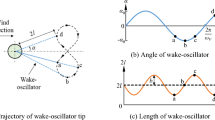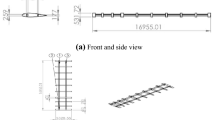Abstract
Structures such as turbomachinery blades, industrial fans, propellers, etc. can be modeled as twisted beams. The study of dynamics of these structures is vital as operational failure of such structures can have catastrophic consequences. As the inclusion of twist and rotation complicates the problem, Finite Element (FE) method is widely used to determine the modal characteristics of rotating twisted beams. In this work, a novel formula is derived to estimate the natural frequencies of rotating twisted beams. The formula is derived using the perturbation method. The twist angle and the rotating speed are treated as the perturbation parameters. In general, the dynamics of rotating twisted beams is coupled in the two transverse planes. However, in the first part of the work the problem is assumed to be uncoupled and it is shown that this assumption is valid under certain cases. In the second part, the problem of general coupled dynamics is solved. Interesting insights based on the formula are presented. The accuracy of the derived formula is verified by comparing it with the literature and FE simulation results. It has been shown that the formula is valid over a fairly large range of twist angles and rotating speeds. In contrast to the detailed FE simulation, the derived analytical formula will be better suited for design iterations in industrial practice.












Similar content being viewed by others
References
Banerjee J (2001) Free vibration analysis of a twisted beam using the dynamic stiffness method. Int J Solids Struct 38(38–39):6703–6722
Banerjee J, Kennedy D (2014) Dynamic stiffness method for inplane free vibration of rotating beams including coriolis effects. J Sound Vib 333(26):7299–7312
Baxy A, Sarkar A (2020) Natural frequencies of a rotating curved cantilever beam: a perturbation method-based approach. Proc Inst Mech Eng Part C J Mech Eng Sci 234(9):1706–1719
Cao D, Gao Y (2019) Free vibration of non-uniform axially functionally graded beams using the asymptotic development method. Appl Math Model 40(1):85–96
Cao D, Gao Y, Wang J et al (2019) Analytical analysis of free vibration of non-uniform and non-homogeneous beams: asymptotic perturbation approach. Appl Math Model 65:526–534
Carnegie W, Thomas J (1972) The coupled bending–bending vibration of pre-twisted tapered blading. J Eng Ind 94(1):255–266
Dawson B (1968) Coupled bending-bending vibrations of pre-twisted cantilever blading treated by the Rayleigh–Ritz energy method. J Mech Eng Sci 10(5):381–388
Dawson B, Ghosh N, Carnegie W (1971) Effect of slenderness ratio on the natural frequencies of pre-twisted cantilever beams of uniform rectangular cross-section. J Mech Eng Sci 13(1):51–59
Di Prima RC, Handelman GH (1954) Vibrations of twisted beams. Q Appl Math 12(3):241–259
Ganguli R (2016) Physics based finite element interpolation functions for rotating beams. Proc Indian Natl Sci Acad 82(2):257–270
Ganguli R (2017) Finite element analysis of rotating beams. Springer, Singapore
Hashemi S, Richard M (2001) Natural frequencies of rotating uniform beams with coriolis effects. J Vib Acoust 123(4):444–455
Hodges DH (1981) An approximate formula for the fundamental frequency of a uniform rotating beam clamped off the axis of rotation. Tech. rep, Army Research and Technology Labs Moffett Field CA Aeromechanics Lab
Hsu MH (2009) Vibration analysis of pre-twisted beams using the spline collocation method. J Mar Sci Technol 17(2):106–115
Huseyin K (1973) The multiple-parameter perturbation technique for the analysis of non-linear systems. Int J Non-Linear Mech 8(5):431–443
Karami G, Farshad M, Banan M (1991) Pretwisted rods- an efficient finite element modelling. Finite Elem Anal Des 9(1):77–85
Kim H, Yoo HH, Chung J (2013) Dynamic model for free vibration and response analysis of rotating beams. J Sound Vib 332(22):5917–5928
Kunte M, Sarkar A, Sonti V (2010) Generalized asymptotic expansions for coupled wavenumbers in fluid-filled cylindrical shells. J Sound Vib 329(25):5356–5374
Kunte M, Sarkar A, Sonti V (2011) Generalized asymptotic expansions for the wavenumbers in infinite flexible in vacuo orthotropic cylindrical shells. J Sound Vib 330(23):5628–5643
Ladde G, Šiljak D (1983) Multiparameter singular perturbations of linear systems with multiple time scales. Automatica 19(4):385–394
Lee SY, Kuo YH (1991) Bending frequency of a rotating beam with an elastically restrained root. J Appl Mech 58(1):209–214
Lee SY, Sheu JJ (2007) Free vibrations of a rotating inclined beam. J Appl Mech 74(3):406–414
Lin S (2001) The instability and vibration of rotating beams with arbitrary pretwist and an elastically restrained root. J Appl Mech 68(6):844–853
Lo H, Goldberg J, Bogdanoff J (1960) Effect of small hub-radius change on bending frequencies of a rotating beam. J Appl Mech 27(3):548–550
Naguleswaran S (1994) Lateral vibration of a centrifugally tensioned uniform Euler–Bernoulli beam. J Sound Vib 176(5):613–624
Nayfeh A (2011) Introduction to perturbation techniques. Wiley, New Jersey
Putter S, Manor H (1978) Natural frequencies of radial rotating beams. J Sound Vib 56(2):175–185
Rao J (1991) Turbomachine blade vibration. New Age International, New Delhi
Sarkar K, Ganguli R (2013) Rotating beams and non-rotating beams with shared eigenpair for pinned-free boundary condition. Meccanica 48(7):1661–1676
Schilhansl M (1958) Bending frequency of a rotating cantilever beam. J Appl Mech 25(1):28–30
Sisto F, Chang A (1984) A finite element for vibration analysis of twisted blades based on beam theory. AIAA J 22(11):1646–1651
Slyper H (1962) Coupled bending vibrations of pretwisted cantilever beams. J Mech Eng Sci 4(4):365–379
Swaminathan M, Rao J (1977) Vibrations of rotating, pretwisted and tapered blades. Mech Mach Theory 12(4):331–337
Tang AY, Li XF, Wu JX, Lee K (2015) Flapwise bending vibration of rotating tapered Rayleigh cantilever beams. J Constr Steel Res 112:1–9
Thomson W (2018) Theory of vibration with applications. CRC Press, Boca Raton
Troesch A, Anliker M, Ziegler H (1954) Lateral vibrations of twisted rods. Q Appl Math 12(2):163–173
Wright A, Smith C, Thresher R, Wang J (1982) Vibration modes of centrifugally stiffened beams. J Appl Mech 49(1):197–202
Yardimoglu B, Yildirim T (2004) Finite element model for vibration analysis of pre-twisted timoshenko beam. J Sound Vib 273(4–5):741–754
Yoo H, Shin S (1998) Vibration analysis of rotating cantilever beams. J Sound Vib 212(5):807–828
Yoo H, Kwak J, Chung J (2001a) Vibration analysis of rotating pre-twisted blades with a concentrated mass. J Sound Vib 240(5):891–908
Yoo HH, Park JH, Park J (2001b) Vibration analysis of rotating pre-twisted blades. Comput Struct 79(19):1811–1819
ANSYS\(^{\textregistered }\) Academic Research Mechanical, Release 18.1, ANSYS, Inc
Author information
Authors and Affiliations
Corresponding author
Ethics declarations
Conflict of interest
The authors declare that they have no potential conflicts of interest with respect to the research, authorship, and the publication of this article.
Funding
No funding received.
Additional information
Publisher's Note
Springer Nature remains neutral with regard to jurisdictional claims in published maps and institutional affiliations.
Appendix
Appendix
In this section, we derive the expression for kinetic energy of a rotating twisted beam. It is assumed that the displacements are harmonic in time. In general, the deformation of a twisted beam is coupled in the x–y and the x–z plane as shown in the figure.
The point P in its reference configuration is deformed to \(P'\) as illustrated in Fig. 13. The position vector of \(P'\) in the rotating frame is denoted as \(\rho _{P'}=x i+w j+v k.\) Velocity of any point \(P'\) in the inertial frame is given by,
where \(\mathbf {v}_{O_{2}}=\varvec{\Omega }\times r\, i\) is the velocity of the point \(O_{2}\) attached to the hub and \(\frac{\mathrm {d}}{\mathrm {d}t}(P')\) is velocity of point \(P'\) in the rotating frame. The kinetic energy of the twisted rotating beam is given by,
where \(\tilde{\omega }\) is the natural frequency of the rotating twisted beam. Equation (21) represents the kinetic energy for the general case of a rotating twisted beam. In case of uncoupled flapwise dynamics, the motion of the beam is restricted to x–yx–y plane. This implies that \(v=0.\) Let \(\tilde{\omega }=\tilde{\omega }_{\mathrm {f}}\) for flapwise dynamics. Thus, the kinetic energy is given by,
Similarly for uncoupled chordwise dynamics, the motion is limited to x–z plan, viz. \(w=0.\) Let \(\tilde{\omega }=\tilde{\omega }_{\mathrm {c}}\) in the case of chordwise dynamics. Therefore, the kinetic energy is given by,
Rights and permissions
About this article
Cite this article
Baxy, A., Sarkar, A. Natural frequencies of rotating twisted beams: a perturbation method based approach. Meccanica 55, 2075–2089 (2020). https://doi.org/10.1007/s11012-020-01238-7
Received:
Accepted:
Published:
Issue Date:
DOI: https://doi.org/10.1007/s11012-020-01238-7





